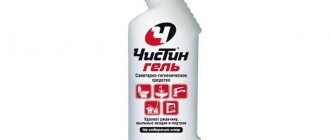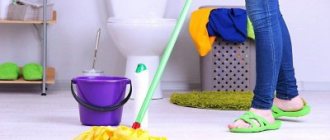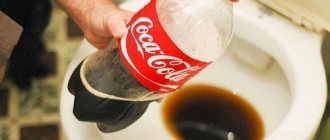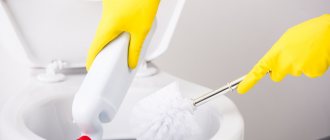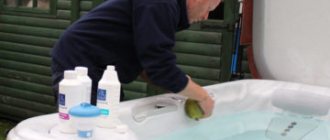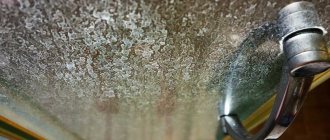Why does urinary stone appear?
Urine stones are composed of mineral components found in human urine. The speed of their accumulation depends on the care of the plumbing - this means that such deposits accumulate most actively when residents do not flush the toilet after themselves.
Cleaning the toilet from urinary stones
In addition, there are other reasons that contribute to this problem:
- Rough structure of the toilet material. With frequent washing with hard brushes, as well as over time, any structure wears out, damage appears on the surface, where mineral deposits quickly accumulate.
- Poor quality tap water. In some regions, the water contains too many minerals, which is why stones or yellowish deposits begin to collect on the walls of any plumbing fixtures.
- Broken tank. Many housewives note that stones form precisely in places where water is constantly in contact with the surface, so when the tank leaks, deposits appear faster.
It is necessary to monitor the serviceability of the tank
This problem is often accompanied by rust. The characteristic cinnamon stains appear due to corrosion of water pipes, therefore, if such a problem is discovered, you should think about replacing them with a practical plastic option.
We are looking for the reason for the appearance
To skillfully solve a problem, it is worth familiarizing yourself with its root causes. What is limescale? These are deposits of minerals contained in the water you use to flush the toilet. These minerals are present in both river water and well water. Thus, the more often the water is flushed, the more the existing problem worsens.
You can not only remove old plaque with your own hands, but also prevent its appearance. In particularly advanced cases, plaque can cause clogging of the hole (or holes) from which water is supplied to clean the interior of the toilet.
A urine stone is a phenomenon that indicates the laziness of the owners, who forget to flush the toilet after themselves after relieving themselves. Drops of urine dry on the walls and lead to the appearance of very unsightly stains, and subsequently to the appearance of urinary stones. It is possible to clean them, but it is much better to prevent them by promptly carrying out sanitary cleaning and cleaning of plumbing fixtures.
Getting ready to clean the toilet
In order to remove mineral deposits from the walls of the toilet and drain, you will need to prepare the following:
- thick gloves;
- devices for removing water (ladle, special vacuum syringe);
- special sponges, brushes, pipe cleaners.
Before starting the toilet cleaning procedure, you must turn off the tap to prevent the flow of tap water. After which you will need to use any container or volumetric syringe to remove the liquid from the toilet. This must be done carefully, and then wipe the surface dry with napkins. Such measures can improve the effectiveness of using cleaning components.
You will need to remove water from the drain hole - you can pump it out with a large syringe
You should definitely wear thick gloves on your hands to protect your skin. When using some components, experts even advise covering your nose with a respirator and your eyes with goggles.
How to pump water out of a drain
The stone is removed using reactive substances, while water in the hole will reduce the efficiency of the process. To get a good result, you need to remove it from the drain elbow at the bottom of the toilet.
Pumping methods:
- in the toilet the water supply is shut off with a valve;
- the liquid is completely drained from the tank;
- use a plunger to vigorously push water into the hole;
- use rags to collect residual liquid.
After cleaning the water, you should not try to scrape off the deposits with metal brushes, knives, or scrapers - you can scratch this area. As a result, stone deposition will accelerate the next time.
Using improvised means
Not in all cases there is a need to immediately use aggressive chemicals to remove organic deposits. There are many effective folk remedies, some of which we inherited from our grandmothers, so they can be considered proven.
Acetic acid: step-by-step instructions
Vinegar is a remedy that can be found in every housewife’s apartment. It has long been known that it is used not only in cooking, but also for cleaning various surfaces from dirt and plaque. Vinegar will also help clean your plumbing.
Step one: first you need to pour the bite into any glass. It should be borne in mind that the liquid must be warm.
If desired, you can heat the container with the bite on the stove
Step two: Next, you need to distribute the vinegar in the areas of the toilet where there are mineral deposits. The product should be left for approximately one hour.
For greater effectiveness, you should soak unnecessary rags in acetic acid and apply them to the surface
Step three: after some time, you will need to remove the softened deposits using a soft silicone or wooden spatula.
You should work with a spatula carefully so as not to damage the walls of the plumbing.
Step four: upon completion of cleaning, you need to wash off any remaining dirt with water.
Flushing the toilet
Soda and vinegar: step-by-step instructions
When using this method, you should not pump water out of the toilet - it should remain moist inside.
Step one: first you need to take one pack of soda and pour it into the drain; it quickly sticks to the wet surface and reacts with mineral deposits. The toilet should sit for 2-3 hours.
The baking soda should cover all dirt and traces with a thick layer.
Step two: now you need to prepare vinegar at room temperature, pour it into a spray bottle and spray it over the surface of the toilet. Then you will need to wait 40-50 minutes.
A reaction of soda with acid will occur, which will speed up the process of softening the stones
Step three: After finishing cleaning, you need to wash the toilet with soapy water.
For the final reading, you can use dishwashing detergent
Vinegar and salt: step-by-step instructions
Cleaning with salt and vinegar is a very effective way to destroy urinary stones, which not only allows you to return your plumbing to its original appearance, but also fights pathogenic microorganisms. Everyone knows the bactericidal properties of salt, and in this case it works against microbes on the surface of the toilet bowl.
Step one: you need to pour vinegar (9%) into a container and heat it to a temperature of 45 degrees.
In order to protect yourself from caustic fumes, the container should be covered with a lid.
Step two: then you need to add 1-2 teaspoons of salt to the container. After which this solution should be poured into the toilet.
The holding time is 1-2 hours
Step three: when the deposits become soft, you will need to flush the water from the toilet tank.
Flushing the toilet
Citric acid: step-by-step instructions
Citric acid has been used for several decades to remove various stains and marks, so a similar product is also suitable for softening organic deposits.
Step One: To be effective, you need to apply the powder in a thick layer, especially if you have large stones. It is better to leave the plumbing in this form for 8-9 hours.
You will need 3-4 packs of citric acid
Step two: after the time has passed, all that remains is to thoroughly rinse the toilet.
Remaining dirt can be easily removed with a brush
Mustard: step-by-step instructions
Mustard is also often used even to remove old dirt from various surfaces, and in combination with other components it will get rid of any mineral deposits.
Step one: first you need to prepare a cleaning paste from the following ingredients: mustard, citric acid and starch.
You need to add water to this mixture to make a thick paste.
Step two: now you need to take a spray bottle, pour clean water into it and spray the surface of the toilet. Now a thick layer of paste must be applied to all areas where there is urinary stone and left for 30 minutes.
After some time, you need to walk over the surface with a brush and flush the toilet with water.
other methods
There are other, equally effective methods of cleaning the toilet:
- Wood soot. To prepare the numeral, you will need soot and citric acid (1 to 1). Then add a little water to the container with these components to make a creamy product. The resulting composition must be applied to the damp surface of the toilet for about 12 hours, and then rinsed off with water.
- Carbonated drink. Various carbonated drinks contain citric acid, which allows them to be used as a cleaning agent not only against urinary stones, but also against rust. The drink “Coca-Cola” is very popular, as it literally dissolves impurities before our eyes. However, to be effective, apply the soda for 5-6 hours and then rinse with water.
Any soda will work for cleaning the toilet. - Soda Ash. It is necessary to mix technical and baking soda in equal proportions, and then add water to create a cleaning mixture. Then this paste should be applied to the stones for several hours. After that, you should intensively rub the surface with a brush, and if desired, you can add bleach to the soda.
- Toothpaste. Using toothpaste, you can quickly clean surface deposits; to do this, you need to apply it to the walls of the plumbing fixtures and rub vigorously with a brush. You can use an old toothbrush to remove dirt under the rim.
- "White". This is a bleach known to all housewives, which copes with washing plumbing no worse than products from well-known manufacturers.
- Iodine monochloride. You can purchase this product at a pet pharmacy. It quickly removes plaque and rust, but is not recommended for use with aluminum pipes.
Video - Removing urinary stones with soda
Household chemicals
Modern manufacturers produce effective cleaning products for plumbing fixtures. Their main advantage is that they quickly destroy any deposits. Let's look at the most popular ones in a little more detail.
Table 1. Effective chemical remedies for urinary stones
| View, illustration | Description |
| "Domestos" | This is an effective product that quickly dissolves limestone and organic stones on the walls of plumbing fixtures and pipes. The substance is released in the form of a gel, due to which it quickly flows over the entire surface. Therefore, the housewife does not have to use brushes while cleaning - just leave the product for 20-30 minutes and then rinse the toilet with water. |
| "Silit" | This product also contains hydrochloric acid, thanks to which it quickly copes with plaque and organic deposits. |
| "Toilet duckling" | This is another effective remedy against plaque and pathogenic microflora. The main active ingredient is hydrochloric acid. Otherwise, the method of application does not differ from the previous one - the gel should be applied to the surface of the toilet bowl, wait a few minutes, and then rinse with water. |
| "Comet" | Means for combating organic stones. It should be applied to contaminated areas for about 25 minutes, and then rub these areas vigorously with a hard bristle brush and rinse with water. |
| "Sanox" | This cleaning product is not only effective, but also affordable. The method of application is no different from the previous one. |
| "Antikalk" | This is a specialized product that was created to remove mineral deposits from the walls of plumbing fixtures. To achieve results, you must follow strict instructions: first you need to apply a drop of the product to an inconspicuous place and check whether the color of the enamel changes. If you are satisfied with the result, you need to apply the gel to the surface of the stains and leave for a few minutes. |
Prices for popular cleaning products for plumbing and pipes
Plumbing and pipe cleaners
Despite the fact that many manufacturers promise gentle care for plumbing fixtures, it is necessary to use any cleaning powders (abrasives) with caution. After all, they contain small grains that allow you to quickly remove dirt from the surface, but at the same time they scratch it. Therefore, if you decide to use such products, then you should not do it too often, otherwise you will soon have to purchase new plumbing fixtures.
Using bleach against rust
The well-known “Whiteness” or any other chlorine-based product quickly copes with urinary stones, plaque and rust. For best results, it is recommended to fill the toilet with bleach for 10-12 hours (at night), and then rinse thoroughly with a brush and clean water.
If desired, you can pre-rinse the plumbing with an alkaline solution, and only then use chlorine. Just remember that alkali and “Whiteness” react, so your face will also have to be protected with a respirator from harmful fumes.
“Whiteness” is a rust remover that has been proven over the years
Potent acids
If too much mineral deposits have accumulated on the walls of the toilet, most cleaning products will not cope with this problem. All that remains is to use acids that effectively corrode any contaminants. However, these products damage the coating of plumbing fixtures, so they should be used extremely rarely.
Table 2. Potent acids
| Title, illustration | Description |
| Orthophosphoric acid | This substance copes with mineral deposits in 8-12 minutes. Apply it liberally to the surface of the dirt and then rinse with water. The main advantage is that the acid does not destroy polymer surfaces, which means it can be used in the presence of plastic sewer pipes. In addition, acid effectively copes with rusty stains that often accumulate in the drain tank. You will need to pour 95 grams of acid into it, wait a few minutes, and then rinse off the water. |
| Concentrated hydrochloric acid (more than 30%) | This is one of the most dangerous acids, so it should be used carefully. First, you need to open the windows in the room and wear rubber gloves. Secondly, you should keep this product on the surface for no longer than 10 minutes, otherwise it will irreversibly damage the coating. In addition, it should only be used in the presence of metal sewer pipes. |
| Oxalic acid | This acid is sold in packages in the form of a light powder. The average exposure time of such a product is 50-60 minutes. The acid can be added either pure or with water. Once cleaning is complete, you will need to rinse the toilet thoroughly. |
| Electrolyte | This acid should be used carefully and for a short time - no more than 8-10 minutes. It is worth understanding that the main component of the product is caustic sulfuric acid, which, together with deposits and plaque, negatively affects the coating of plumbing fixtures. |
Video
The presented videos will help you understand in more detail the rules for cleaning a toilet cistern:
About the author:
Found a mistake? Select the text with the mouse and click:
Do you know that:
Fresh lemon is not only suitable for tea: clean dirt from the surface of an acrylic bath by rubbing with half a cut citrus, or quickly wash the microwave by placing a container of water and lemon slices in it for 8-10 minutes at maximum power. The softened dirt can simply be wiped off with a sponge.
Cleaning the toilet rim from dirt
The process of cleaning the toilet rim and the space under it is not particularly different. The difference is that in such hard-to-reach places it is recommended to apply the products pointwise, using old rags. In addition, you can use special cleaning products with a curved spout (for example, Domestos or Toilet Duck). It is recommended to apply cleaning gels every three to four days to prevent the formation of persistent stains.
Most cleaning products come in easy-to-clean packaging under the toilet rim
Cleaning company services
Long-term stains and old rust marks are difficult to deal with at home, so many housewives prefer to use the services of specialists. They have special equipment and a full arsenal of all devices and chemicals. The only downside is that such a service has a high cost.
However, turning to cleaning specialists for help has clear advantages. Firstly, you won’t have to waste time doing less than pleasant work. Secondly, people with respiratory problems, asthmatics and allergy sufferers, in principle, should not have contact with caustic household chemicals, and it would be more logical for each person to refuse to try to wash the plumbing on their own if they are protecting their health.
The company’s specialists will cope with pollution of any complexity
What to do if there is a blockage from urinary stones?
Sometimes urinary stones form on the inside of the drain, making it impossible to apply a cleaner to them. In this case, mineral deposits cause blockages.
Special pipe cleaners will help in this matter, which effectively break down not only fat plugs, but also urinary stones.
Important point! If clogs appear too often, you will need the help of professional cleaners.
Table 3. List of products used for cleaning pipes
| Title, illustration | Description |
| "Mister Muscle" | In this case, it is recommended to use a granular product from this manufacturer. To do this, you will need to apply granules to the moistened surface, leave for a while, and then clean the toilet with a brush. At the end of cleaning, it is necessary to rinse the plumbing fixtures with water. If there are stones inside the drain, you will have to pour granules there. |
| "Mole" | It is produced in the form of liquid, gel and granules. This substance effectively fights any organic type formations. Features of application: 1. First, you need to pour hot water into the drain hole. 2. Then pour the product in the amount of one glass and leave for 60-70 minutes. 3. Then you need to wash off the “Mole” with a powerful stream of water. |
| "Tiret" | The exposure time of this product is 10-15 minutes, but it may take about an hour to soften the stones. It is also used with boiling water in the amount of one glass. The components that make up Tiret best eliminate pathogenic microorganisms. |
| "Floop" | The advantage of this product is that it can be used even in the presence of plastic sewer pipes. They use it in the same way as previous products; it is important to remember that the green packet can be diluted in cool water, and the red one can only be diluted in hot water. |
Mechanical impact
If there is a too dense layer of stones, you can get rid of it mechanically using a hammer and screwdriver. But you should work carefully so that the tools do not touch the plumbing, because with a strong impact you can not only damage the coating, but also split the structure.
Due to mechanical stress, the toilet may become unusable
Prices for toilets, urinals, bidets
Toilets, urinals, bidets
Let's take stock
If you want to keep the toilet in its original form for many years, then you should not neglect hygiene procedures. Any old stains and deposits will be more difficult to remove, so you should spend at least half an hour a week cleaning your plumbing.
How to prevent the formation of urinary stones?
How to clean a toilet from limescale? Read more in the special article.
Prevention measures
There are several ways to prevent rust:
- 1If the problem is related to poor quality water, then it is recommended to install a filter.
- 2First of all, adjust your toilet tank so that water does not leak out of it. You can do this yourself. To do this, you need to bend the float lever in the tank. This technique will reduce the amount of water used.
- 3Use of special products for water in the tank: they come in the form of soluble tablets, powder or solution. Such compositions color the water a pleasant color, refresh the air, and prevent the formation of rust and other deposits.
- 4It is recommended to replace the earthenware toilet with a new analogue, since dirt and rust settle faster on a rough surface and penetrate deeper. It is recommended to buy plumbing fixtures with a special water-repellent glaze.
- 5When choosing plumbing fixtures, preference should be given to products coated with a water-repellent substance. They are more expensive than usual, but effectively prevent dirt and rusty deposits from settling on the walls of the toilet.
- 6If minor breakdowns occur, they should be corrected in a timely manner.
- 7It is easier to remove fresh stains than old ones, so it is recommended to constantly clean the toilet and keep the toilet clean.
If you follow the above recommendations, the toilet will shine clean and last a long time.
